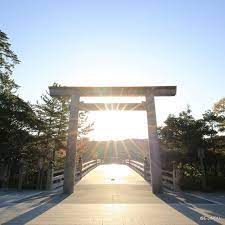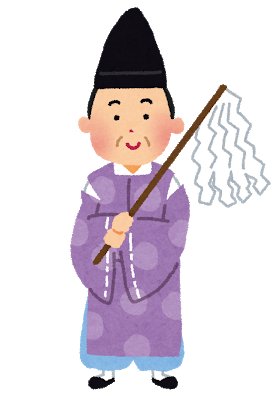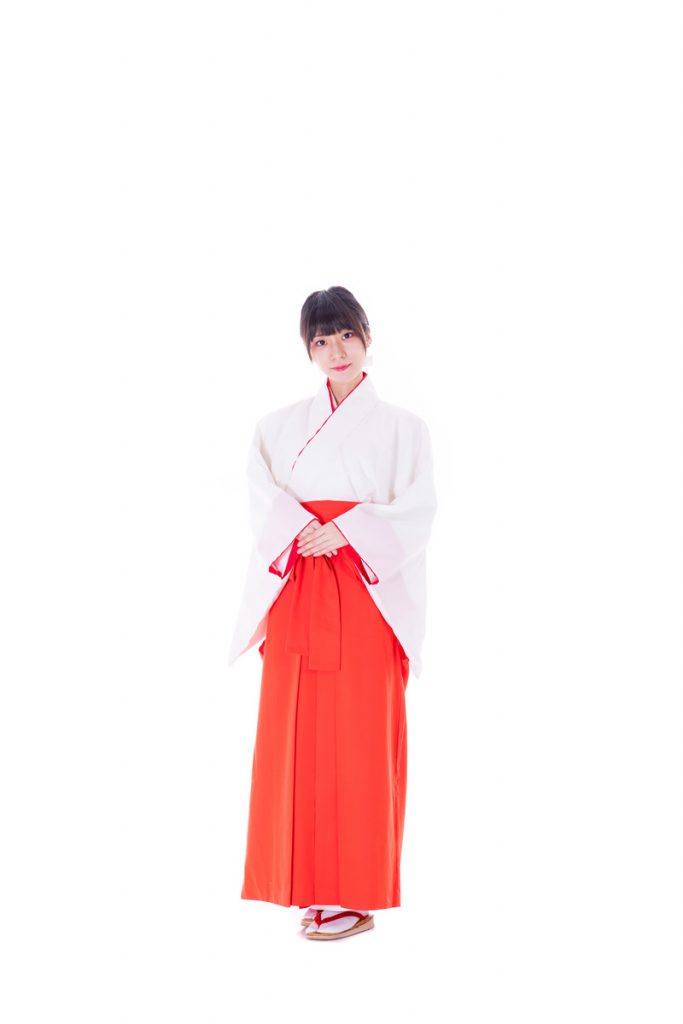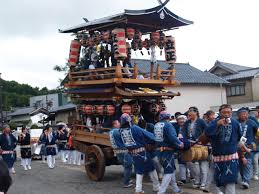
From an ancient age, Japan is a country many religious has come and blended into 和風【WA-FUU(Harmonized Style)】. The same is true in religious. Japanese religions are very roughly divided into three kinds;神道【SHINTOU】,仏教【BUKKYOU】and 儒教【JYUKYOU】and all of them are united with people’s daily life naturally.
▶ESSAY: Why we often call Japanese style “和風【WA-FUU】”=「harmonized style」 instead of ”日本風【NIHON-FUU】“=「Japanese style」? Is Japan a country harmonized even religions?七福神【SHICHI-FUKU-JIN】or “Seven Lucky Gods” is an exhibition of world deities.
▶ESSAY: How different 神【KAMI】of “one god religious” to Japanese 神道【SHINTOH(SHINTOISM)】?
3-(1)▶History of Japanese religious. From national religion 神道【SHINTOU(Shintoism)】to 仏教【BUKKYOU(Buddhism)】and 儒教【JYUKYOU(Confucianism)】, they were imported from continent.
All Japanese are belong to nearest shrine where he or she was born as 氏子【UJIKO】Shrine parishioner, so all Japanese are natural born Shintoist, regardless of they are conscious it or not.
3-(2)▶神道【SHINTOU】All Japanese are natural born Shintoist belong to 神社【JINJYA(SHRINE)】of their region as a 氏子【UJIKO】.
At the same time, much of Japanese are 仏教徒【BUKYYOU-TO(Buddhist)】belonging to a temple as 檀家【DANKA( Supporting Family)】.
3-(3)▶仏教【BUKKYOU】At the same time, much of Japanese are Buddhist. Japanese Buddhism is broadly divided into 6 kinds.
That’s a reason that Japanese total religious population is more than Japanese population.
4. 儒教【JYUKYOU】Confusionism influences Japanese education or corporate culture.
5. Conclusion
<CONTENTS>
3. 仏教【BUKKYOU】At the same time, much of Japanese are Buddhist. Japanese Buddhism is broadly divided into 6 kinds.
▶ESSAY: How to recognize temples and shrines in Japan?
5. Conclusion
In an ancient time called 縄文時代【JYOUMON-JIDAI(Rope pattern pottery era/BC14000-BC3000※lasted about 10000 years)】, Japan was a country of Animism every things have their own spirits and great things like mountains, rocks, fire, and even humankinds could become 神【KAMI】.
In 6th. century, Buddhism was brought from Eurasia continent ( born at India, via ancient China and Korean peninsula).
A great politician named 聖徳太子【SYOUTOKU-TAISHI】had accepted and improved 仏教(Buddhism) and 儒教(Confucianism) , and said 和【WA(Harmony)】is precious and tried to harmonize those religious. He was killed by somebodies, but his thoughts are remaining in Japanese people’s minds and history, then he become pictures of bills as much as 7times( it is the high record).
After that, although there have been several conflicts including fierce ones, in Japan, 神道【SHINTOU】, 仏教【BUKKYOU】and other religious are coexisting.
During W.W.2, The 天皇【TENNOU(Emperor)】, the center of 神道(Shintoism), believed as the 神【KAMI(God)】 and used as a symbol of militarism. After the war, he became just a symbol of Japan country. Any religious are separated from politics and people’s freedom of religions is guaranteed.
There are a lot of shrines and temples from very small to huge ones, every where in Japan, even small town or villages.
Nowadays, there are so many 神社【JINJYA(Shirines)】in all towns and people visit there in happy occasions like baby birth, celebrate children’s grow in their 7-5-3 years old, weddings. A lot of 祭【MATSURI(Festivals)】are hold especially in summer .
There are also many お寺【(O)-TERA(Temples)】and people use them as funerals, passed person’s memorial ceremonies after their death’s 7th day, 49th day, 1st year, 3rd year, 7th year. People go to their ancestor’s graves in お盆【O-BON】and お彼岸【(O)-HIGAN】, and some temples have festivals called 縁日【EN-NICHI】.
儒教【JYUKYOU(Confucianism)】is rather philosophy than religion, and it’s taught are still living in Japanese way of school education, and company mottos which was spread to the world in high economic period with overseas expansion of Japanese companies in around 1990’s.(And sometimes 道教【DOU-KYOU(Taoism)】influences particular peoples like who admire a life style, for example, fishing all day long in nature).
There are also new religions, churches for Christians and Mosques for Muslims living in Japan, too.
Conclusion;
However, not less Japanese peoples say they are non-religious when they asked “What is your religion?”. There are so many shrines and temples in each towns, but they only visit them in special occasions like festivals, events or sightseeing. It is not like Christian people go to church every Sunday. Usually, there is not a custom like baptism(except some new religious). It would be surprise for foreigners who have strong faiths, but it can not be said that Japanese are not religious people.
Many faiths (which are Shinto, Buddhism and sometimes Confucianism) are blending into their daily lives , way of thinking and spirituality of the Japanese people, and even their lives themselves can be religious.
Many faiths are blending into their daily lives and spirituality of the Japanese people, and even their lives themselves can be religious.
That’s one of a reason it is said that Japanese peoples have high public morals ; late of crimes is low and women can walk alone in the night, and news which people help each other at the times of natural disasters like earthquakes without rioting and looting surprise the world.
儒教【JYUKYOU】or Confucianism was formulated by孔子【KOUSHI】in ancient China as
春秋戦国【SYUN-JYUU-SENGOKU】:Spring and Autumn Warring State Period (BC770-BC221).
It emphasis on ancestor worship and devotion to parents,family and friends and it
influence on social system like company or school of Japanese.
Japanese Buddhism is divided into 6 sects roughly.Japanese people celebrate their birth or weddings in 神道【SHINTOU】”Shintoism” and have funerals in 仏教【BUKKOYU】 “Buddhism” way.
In addition to them,儒教【JYUKYOU】”Confucianism “seems influence to education in school or company disciplines.
They are blended into people’s daily life and the way of thinking naturally(And sometimes 道教【DOU-KYOU】influences particular peoples).



宗教【RELIGION】: Differences of World religions and Ethnic religions.
儒教【JYUKYOU】My experience about differences of classrooms in Japan and America
There are a lot of shrines and temples from very small to huge ones, every where in Japan, even small town or villages,
1. 神道【SHINTOU】or ”SHINTOISM”: All Japanese are natural born Shintoist .

All Japanese belong to nearest 神社【JINJYA】Shrine as 氏子【UJIKO】, “lineage children” when they were born.
神道【SHINTOU】is Japanese 【皇室】Imperial Family’s Religion and supreme deity is a Goddess named 天照大神【AMATERASU-OOMIKAMI】.
The top of Shrine is 伊勢神宮【ISE-JINGUU】in 三重【MIE-PREFECTURE】and there are countless 神社【Jinjya】 shrines in all over Japan. You can find so many small and large 神社【JINJYA】shrines all over Japan even in very small villages.
All Japanese are belong to nearest shrine where he or she was born as 氏子【UJIKO】Shrine parishioner, so all Japanese are natural born Shintoist, regardless of they are conscious it or not.
▶How different 神道【SHINTOU】and 仏教【BUKKOY】?
(It is said that SHINTOU is regional religion while Buddhism (Christianity or Islam, too ) is World Religion which have many believers all over the world regardless regions and countries).
Peoples go to 神社【JINNAYA】Shrine when babies are born and greet with 神様【KAMI-SAMA】of their region as 初宮参り【HATSU-MIYA-MAIRI】”First Imperial Visit”. When Children become three, five and seven years old, families go to shrines and say thanks to 神様 and this event is called 七五三【SHICHI-GO-SAN】literally mean “Seven-Five-Three”.
Many people go to 初詣【HATSU-MOUDE】,The first visit to Shrine in the year on January 1st. And Wedding ceremonies are hold in Shintoism Way(Recently, Christianity style wedding ceremonies are popular, too ).





At 祭【MATSURI】Festivals, much of them are hold in summer, young men carry 神輿【MIKOSHI】potable shrine or vehicle 神様【KAMI-SAMA】and move towns liver.y towns have their own called and young men from the town carry portable shrine 神【KAMI】is on.
▶ESSAY about 宗教【RELISION】: How different Japanese 神【KAMI】dieties and GOD?
仏教【BUKKYOU】Buddhism has imported from India through ancient China and Cyosen peninsula to Japan in AD5. Japanese Buddhism had been developed into some original and kind of unique ways.Nowadays, Japanese Buddhism deal with funerals and memorial services hold after
7days,49days,1year,3years,7years after one’s death.
People go to the temple and pray for tombs of ancestors in お盆【O-BON】in summer and
お彼岸【O-HIGAN】in Spring and Autumn.
After Buddhism has brought from Eurasia continent ,many unique sect has been appeared and developed in Japan.
They could be able to devided into roughly 6 kinds:

1.奈良仏教【NARA-BUKKYOU】A sect which is most basic that 釈迦【SYAKA】
Gautama Siddhartha’s taught was based on . 南都六宗【NANTO-ROKUSYUU】.
They are teaching basic Buddhism philosophy.
2.浄土宗/浄土真宗【JYOUDO-SYUU/JYOUDO-SIN-SYUU】



浄土宗/浄土真宗【JYOUDO-SYUU/JYOUDO-SIN-SYUU】literally means “Pure land Sect” and
“Real Pure Land” Sect.
A key word is 南無阿弥陀仏【MAMU-AMIDABUTSU】. This word is also called 念仏【NEN-BUTSU】.
南無【NAMU】means “I believe strongly” “I am devoted to”. 阿弥陀仏【AMIDA-BUTSU(AMITABHA BUDDHA)】is 仏【BUTSU/HOTOKE/ BUDDHA(Someone who got enlightenment)】who ruins 浄土【JYOUDO(Pure Land)】.
So, Believers pray “please make me reborn at pure , paradise land where Amitabha Buddha ruins, after I dead”.
A monk 法然【HOUNEN】started it 浄土宗【JYOUDOSYUU-SECT】in 鎌倉【KAMAKURA】era and he
It is said that only chanting 南無阿弥陀仏【NAMU-AMIDABUTSU】or 念仏【NENBUTSU】will save you.
His disciple 親鸞【SHINRAN】made 浄土真宗【JYOUDO SHIN SYUU-SECT】and he said even evel doers would be served if they chant 念仏【NENBUTSU】haldly.
Many cases, statues of 阿弥陀仏【AMIDA-BUTSU】/阿弥陀如来【AMIDA-NYORAI】are followed by 観音菩薩【KANNON-BOSATSU】in the left and 勢至菩薩【SEISHI-BOSATSU】in the right.
How different 仏【HOTOKE】and 如来【NYORAI】?
仏陀【BUTSU/HOTOKE】is a person who reached 悟り【SATORI(Enlightenment)】like 釈迦仏(釈迦【SHAKA】is a founder of Buddhism and he was born a prince of small country.
如来【NYORAI】is the highest 仏 like 阿弥陀如来 or (薬師如来【YAKUSHI-NYORAI】, 大日如来【DAINICHI-NYORAI】). 如【NYO】is “The Truth and Varity” and 来【RAI】is “Come”. Then, 如来【NYORAI】means It Who Comes From The Truth/Varity.
観音菩薩【KANNON-BOSATSU】 appears 慈悲【JIHI(mercy and compassion)】and having lotus flower while 勢至菩薩【SEISHI‐ BOSATSU】do 智慧【CHIEI(Wisdom)】and having water vase.
Famous Examples of 阿弥陀如来像【AMIDA-NYORAI STATUE】:


鎌倉大仏
3.日蓮宗【NICHIREN-SYUU】/A monk 日蓮【NICHIREN】is a founder.
A key phrase is 南無妙法蓮華経【NAMU-MYOUHOU-RENGE-KYOU】.
“I’m dedicated in rare and splendid Lotus Sutra,which is the last sutra 釈迦【SHAKA】taught .


4.禅【ZEN】Sect/Sitting and meditating to be the mind of 無【MU】”nothing “reaching for enlightenment.
Key sutla is 般若心経【HANNYA-SHIN-GYOU】means “sutla of true wisdom” and it
explain about 空【KU】”empty”.


⇒ JAPANESE CULTURE EXPERIENCES:You can experience 座禅【ZAZEN】at temple.
5.密教【MIKKYOU】Secret or hidden taught-Sect,trying to connect with Buddhas directry with secret ways.
曼荼羅【MANDARA】is a pattern which universe are explained with various kinds of Buddha.
大日如来【DAINICHI-NYORAI】is in the center and he is a creator of the universe.

⇒TOUR TO 寺町【TERA-MACHI】,Town of many Temples.You can watch every kinds of Japanese temples!
<西堀【NISHI-BORI】Street/沼垂【NUTTARI】Town/<新潟【NIIGATA】City
<3>儒教【JYUKYOU】CONFUCIANISM
儒教【JYUKYOU】or Confucianism was formulated by孔子【KOUSHI】in ancient China as
春秋戦国【SYUN-JYUU-SENGOKU】:Spring and Autumn Warring State Period (BC770-BC221).
It emphasis on ancestor worship and devotion to parents,family and friends and it
influence on social system like company or school of Japanese.

Leave a Reply